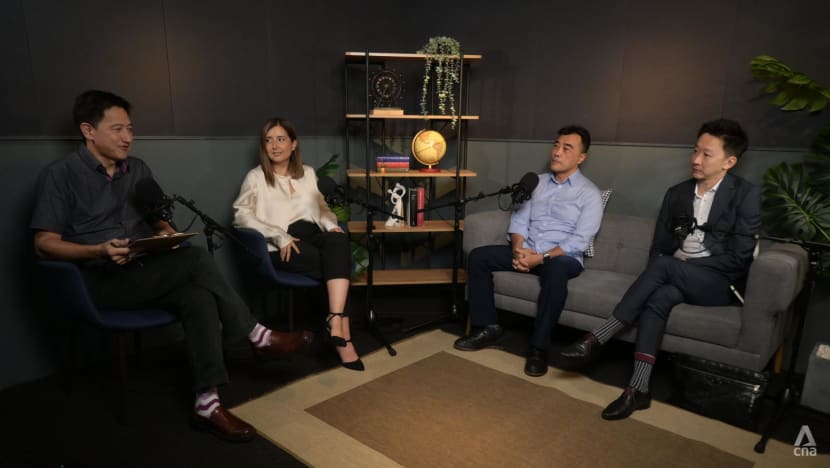Making sense of scams: Who should pay for them?
Apportioning blame when a scam takes place is complicated given that there are many stakeholders and every scam is different, experts tell CNA podcast Heart of the Matter.

A person receiving a phone call from an unknown number. (File photo: iStock/ronstik)
SINGAPORE: When she got a call warning her of an outstanding bill amounting to more than S$1,000 at Singapore General Hospital, Mr Ho Geer How’s mother was initially sure it could not be true.
She knew she did not have any checkups or reviews during that time period, after all. But the scammers on the other end of the phone line were so convincing that she eventually believed that her identity had been stolen.
The 76-year old was transferred from one person to another on the phone and spoke to multiple scammers in an elaborate trap. They convinced her that she was involved in money laundering, and that she was being investigated by the Monetary Authority of Singapore and the police.
Fearing she would be jailed or lose her permanent residency status, she cooperated with the scammers, whom she believed were the authorities, by transferring a total of S$190,000 (US$139,000) over a few transactions at the bank.
The incident came as a surprise to her son not just because of the money lost but also because his mother was aware of scams. Mr Ho, who was a victim of a scam himself, had educated her on them.
“That was really scary because my mum wasn't that stupid. I even live demo to her on a call with a scammer that this is what you should be dealing with, (these are the) telltale signs,” he told CNA podcast Heart of The Matter.
FINDING OUT ABOUT THE SCAM
For the two weeks following the scam call, his mother appeared completely normal. Despite sharing the joint account from which she had withdrawn large sums from, Mr Ho was not alerted to any movement of the money, he said.
When he finally saw the withdrawals and checked with his mother, she said she authorised the transaction but refused to share the circumstances, saying she was busy.
When he checked with her again on whether she had been scammed, she was reluctant to reveal details, so Mr Ho got suspicious. He eventually took her to the police station.
“I could see that she was very confused and she was made to believe that the story (that the scammers told her) was true,” he said, adding that the perpetrators were successful in psychologically manipulating her.
Mr Ho said that he was left with some questions following the encounter.
He wanted to know why he was not notified of the first withdrawal of S$70,000 – an unusual amount, despite being a joint account holder.
Another issue he had was the method the bank teller used to ascertain if his mother had been scammed, he said.
“The bank teller, actually asked my mum: ‘Auntie, are you being scammed?’” Mr Ho recounted.
“Nobody in the right mind would actually say ‘yes, I'm being scammed. Please help me’,” he said, adding that the scammers would have already convinced the victims by that point that they are not being cheated.
Since the incident, Mr Ho has set the withdrawal limit for the account to S$500.
“There's probably nothing I could have done, but I would have educated her differently,” he said.
WHO IS TO BLAME?
Mr Ho’s mother is not alone – there were nearly 23,000 scam cases in the first six months of this year, with increasing sophistication from the fraudsters.

However, apportioning blame when a scam takes place is complicated given that there are many stakeholders and every scam is different, said experts who joined the show to weigh in on the issue.
In the United Kingdom, laws to get the financial institutions to reimburse monies cheated in scams – only if there is no gross negligence or fraud on the consumers’ part – are set to kick in next year.
The main idea is that payment services are the best parties to deal with this issue using fraud surveillance and data-driven tactics, said Mr Jansen Chow, co-head of fraud, asset recovery and investigations practice at law firm Rajah & Tann.
If there are legal obligations on these institutions where they may be potentially liable to reimburse, they may be driven to improve their systems, he added.
Banks here have set up systems to deal with fraud cases over the past few years, and have been trying to improve, he said.
When technology is involved in a scam, social media platforms and digital intermediaries that disburse content online have to play their part – for instance, by taking down fake ads, said Assistant Professor Nydia Remolina from the Singapore Management University’s Yong Pung How School of Law.
She cited China, where companies are obliged to take down fake information or advertisers.
However, she acknowledged that there is a wider cross-border issue and that different jurisdictions practise different rules.
“On a worldwide level, China could do something but if the United States is not doing the same, and we interact with many platforms that are based in the US, that's not going to be applicable to them,” she said.
CAN SUCH SCAMS BE PREVENTED?
There is no perfect solution to the problem, especially given that many of them are cross-border in nature, the experts said.
Preventive campaigns to educate financial consumers are just one solution to the problem, said Asst Prof Remolina.
“There are many behavioural elements of these cases and psychological elements that fraudsters use that make those preventive campaigns just one element in the big puzzle of preventing these scams,” she said.
“We cannot burden the financial consumer with everything in terms of preventing the scams,” she added.
While there may be preventive measures in place, it becomes tricky when an individual is duped so convincingly that they proceed to part with their money despite being warned, said Mr Chow.
He referred to a case in the UK where the victims – a couple – were so convinced by fraudsters that they chose to transfer £700,000 (US$850,000) into two bank accounts in the United Arab Emirates despite the police alerting them to a potential scam.
The victims later sued the bank, Barclays, which won the case on appeal.
It is hard for banks to be the “parent”, said Mr Chow.
“A bank's duty is to act on your instructions. It's not there to parent, to tell you that you're making bad choices. I don't think we want that as well,” said Mr Chow.
“If I want to buy an extra cake, I don't want a bank to tell me ‘you shouldn't eat that cake tonight’. Where do we draw the line?”
MORE COMPLEX SCAMS ON THE HORIZON
Tackling scams will become more urgent with rapidly advancing technology, said Asst Prof Remolina.
Fraudsters are using artificial intelligence (AI), particularly generative AI, to fake the voice of a person who their victim is familiar with, she said.
In such a situation, if someone who claims to be a victim’s mother – and sounds like it – calls and requests for money, it would be easy for the victim to let their guard down, she said.
“Even if the bank calls me (to tell me that was an AI-generated voice), no one is going to convince me that that wasn't my mum,” she said.
Among the ways to manage the scourge of scams is more cross-border conversation, she said.
“In the financial sector, we have seen this before in terms of capital requirements applicable to the financial sector, prudential requirements, preventing money laundering,” she said.
“Maybe we need to … create a solution on a cross-border level in terms of collaboration between different jurisdictions and authorities, or even industry players located in different jurisdictions in terms of how to trace the monies, and how to help customers to get their monies back.”











.jpg?itok=I5dBPkj5)






